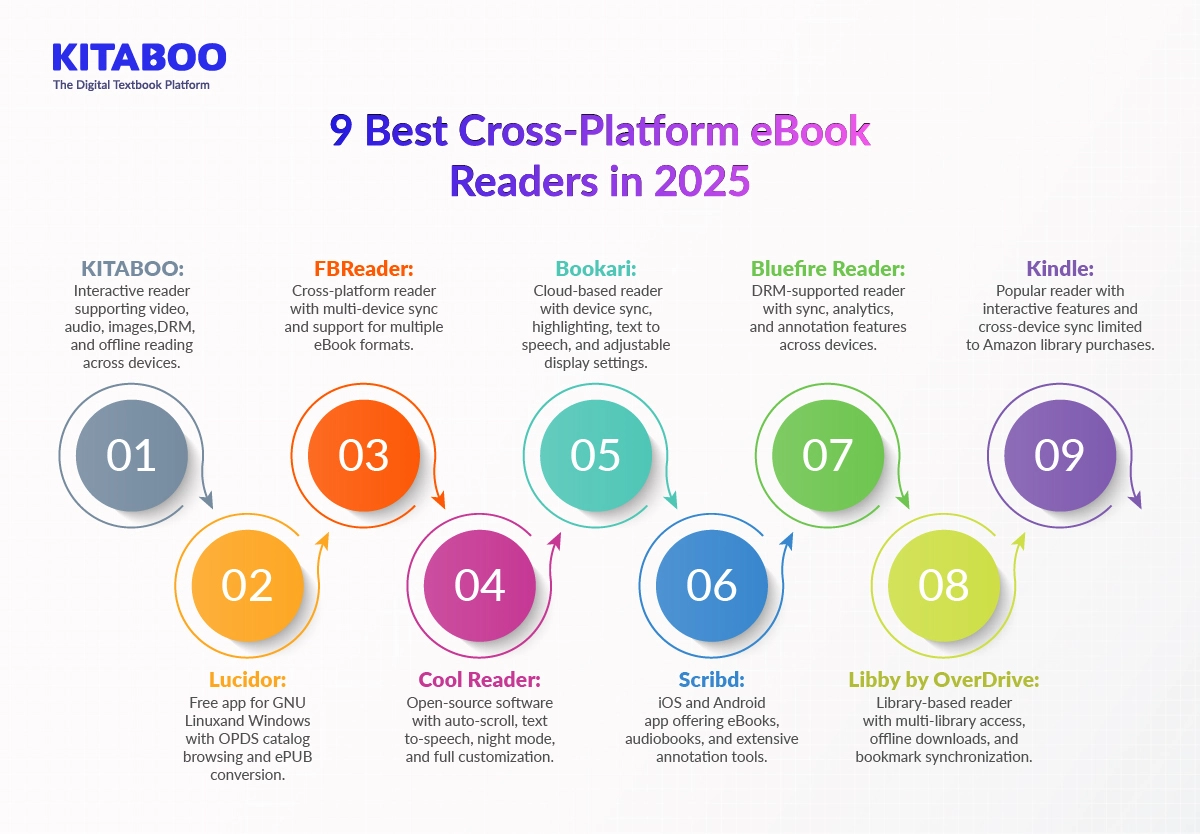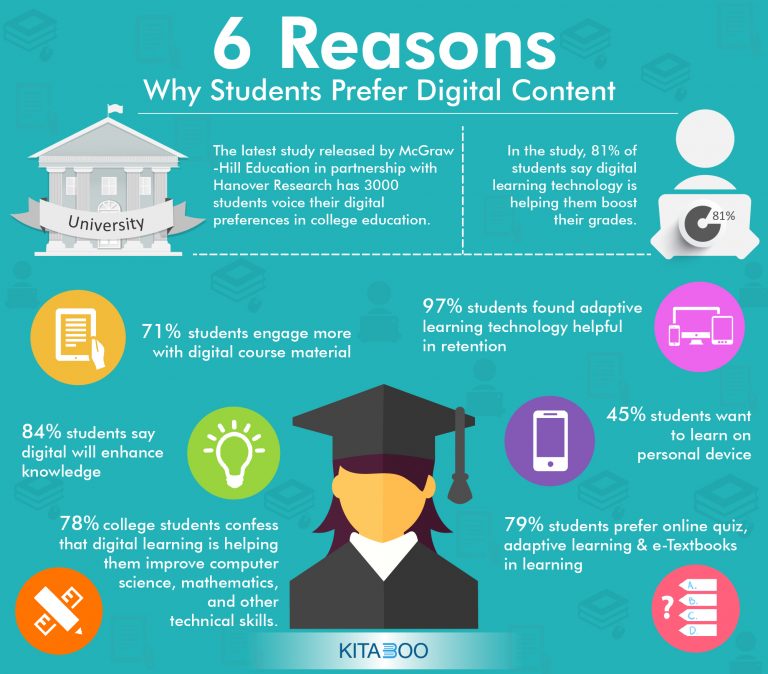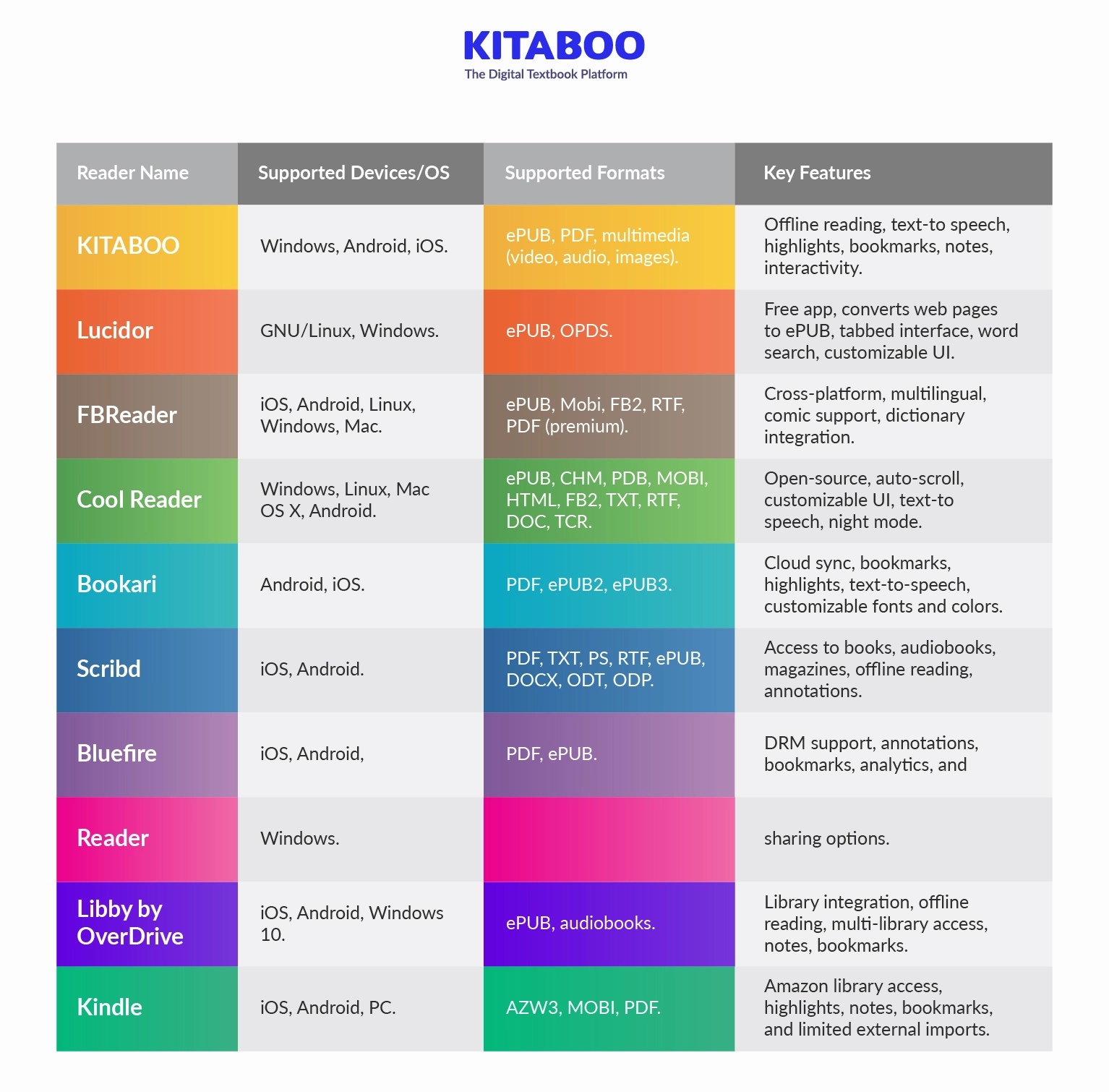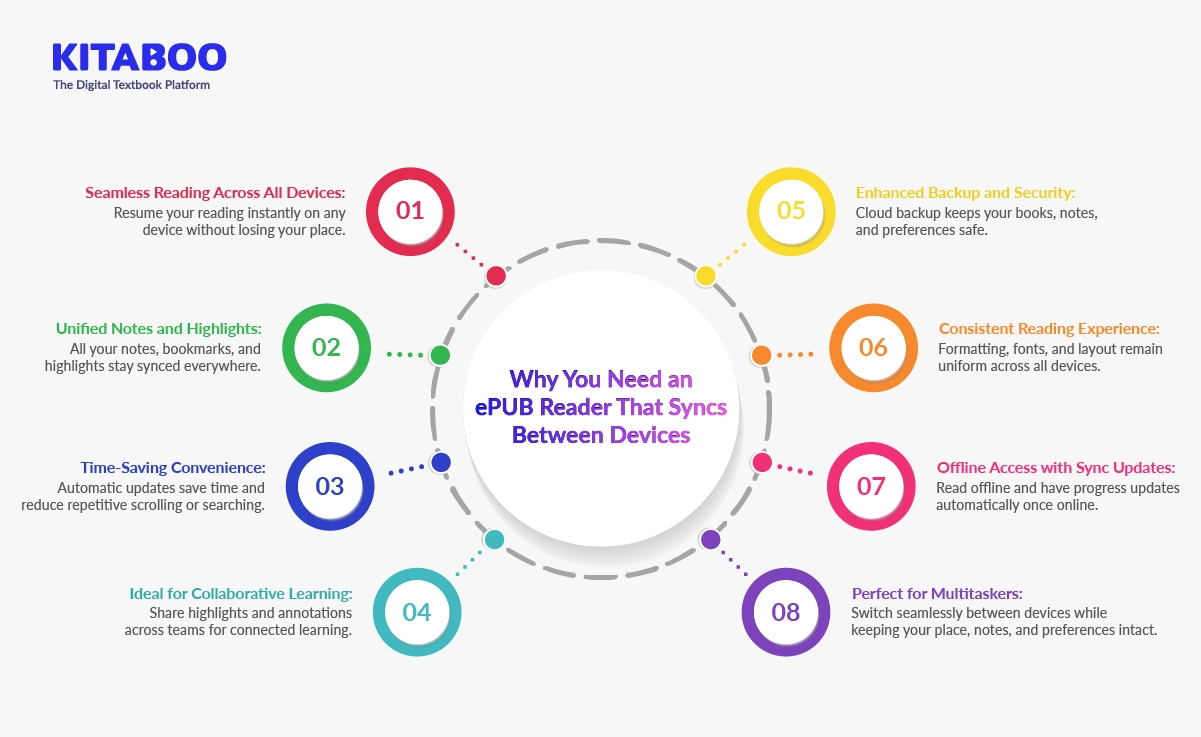
9 Best Cross-Platform eBook Readers in 2026
Summarize this blog with your favorite AI:
An EPUB reader that syncs between devices helps users maintain progress, highlights, and notes across all devices. This allows readers to pick up right where they left off, no matter the device they use. It also ensures a smooth, uninterrupted reading experience for students and casual readers.
Different readers cater to various needs, from interactive learning to simple text reading. Choosing the right app depends on whether you value offline access, multimedia support, or cloud syncing.
Here is a snapshot of the top 9 cross-platform eBook readers and what makes them stand out.
| Reader Type | Best For | Highlight Feature |
|---|---|---|
| KITABOO | Publishers, Authors & Institutions | Interactive multimedia and offline access. |
| Lucidor | Linux & Windows Users | Free access to OPDS catalogs. |
| FBReader | Multi-device Users | Syncs bookmarks and progress across platforms. |
| Cool Reader | Customization Fans | Auto-scroll and night mode. |
| Bookari | Frequent Readers | Cloud sync and annotations. |
| Scribd | Content Explorers | Access to books, audiobooks, and magazines. |
| Bluefire Reader | Professionals | Analytics and DRM support. |
| Libby by Overdrive | Library Enthusiasts | Borrow and sync library books easily. |
| Kindle | Amazon Users | Vast collection of titles with device sync. |
It’s no secret that educational publishers & institutions have moved on from traditional books to eBooks. Although an eBook can be far more comfortable and convenient than a paperback, it comes with its own set of prerequisites. For traditional reading, a learner only needs a book in hand.
To read an eBook however, you need more than just the eBook. A learner would either require a dedicated eReader or a reading app on their mobile device. eReading applications work only on specific operating systems that they are designed for. And that is why you need a cross-platform eBook reader.
Explore: Digital Publishing Platform for Association and Societies
In order to avoid switching applications and re-organizing the eBook collection, readers must opt for a cross-platform eBook application which will accept most types of file formats and can run on more than one operating system. To make the learning experience you provide more seamless, I’ve listed a few eBook Readers you could explore.
9 Best Cross-Platform eBook Readers Available Right Now -
1. KITABOO:
KITABOO is an interactive eBook reader app. It is compatible with Windows, Android and iOS operating systems. Students can download the eBook and read them anytime on their devices with its offline reading feature.
This application accepts most of the file formats. KITABOO has an autoplay option which will open the book and read aloud the text, page by page. You can make notes, bookmark pages, highlight texts, etc.
The KITABOO reading platform also supports video, audio and images and provide an interactive to its readers.
Also read: Devices and Operating Systems that support the Kitaboo Reader
Below is a detailed walk through of the KITABOO eReader application, capable of giving the best learning and reading experience over a range of devices.
2. Lucidor:
Lucidor mainly runs on GNU/Linux and Windows platforms. This reader application supports eBooks in the ePUB file format and catalogs in the OPDS format. It is a free app which allows you to read and manage your eBooks with ease.
You can browse the OPDS catalogs on the internet and download books online. This tool also converts the web feeds and web pages into ePub eBooks. You can customize this app as per your liking.
It lets you highlight and adjust your texts and search for words within the content. Lucidor also lets you open multiple eBooks at once with the help of its tabbed interface.
3. FBReader:
The FBReader (Favourite Book Reader) app is a cross-platform eBook reader available for iOS, iPhone and Android, Linux, Windows, and Mac OS. It allows you to read your eBooks on a desktop as well as handheld reading devices.
This application supports most of the eBook formats, such as ePUB, Mobi, FB2, RTF and more. One of its main features is synchronization. FBReader allows students to sync their eBooks and bookmarks across multiple devices and platforms. This app can be localized into 29 different languages. You can even read comic books with plugin support if you are using the free application.
If you opt for a premium edition, there’s built-in support available for PDFs and comics. You can access popular dictionaries like ColorDict, SlovoEd, Fora, etc. to look up words.
Click on the image below to view an infographic about 6 reasons students prefer digital content
4. Cool Reader:
Cool Reader is an open source eBook reader software that runs on Windows, Linux, Mac OS X, and Android devices. It supports a range of eBook file formats such as ePUB, CHM, PDB, MOBI, HTML, FB2, TXT, RTF, DOC, TCR.
It has a fully customizable palette, allowing you to change the look and feel of the eBook as per your preference. The cool reader has an auto-scroll feature which will automatically turn your page for you. Other features include bookmark system, text adjustments, text to speech and night mode option.
5. Bookari:
This eBook reader works well on Android and iOS devices. It is a cloud-based application, which lets you sync your devices to the app to retrieve your books and annotations from other devices. It allows you to bookmark and highlight text, change the font size and background colors etc.
Bookari is compatible with PDF, ePub2 and ePub3 formats and the Adobe DRM technology. It offers a text to speech feature which underlines sentences as they are read. You can download and store all your eBooks in the Bookari library and read them later.
The number of devices that can be synced depends upon the subscription plan that you opt for. The free app only allows partial synchronization between two devices, while a premium subscription allows you to synchronize notes and annotations between 30 devices.
6. Scribd:
This cross-reader application is well supported on iOS and Android systems. It requires iOS 10 or newer versions to play on your Apple devices. If you are using an Android app, then you require a device with Android 4.4 (KitKat).
You can access a number of eBooks, audiobooks, magazines, sheet music and more on Scribd. Scribd supports a variety of file formats such as PDF, txt, ps, rtf, ePUB, key, odt, odp, docx, etc. You can annotate, highlight, bookmark, and save books in the app for offline reading.
7. Bluefire Reader:
The Bluefire Reader is available for Apple iOS, Android, and Windows PCs. It allows you to highlight, annotate and bookmark texts, search, share and more. You can read DRM protected as well as DRM free eBooks with this application.
It supports PDF and EPUB file formats. Its analytics feature provides information about your user’s reading patterns. Its sync feature lets you move between multiple devices without losing track of the current page.
8. Libby by Overdrive:
Libby is compatible with iOS, Android, Window 10 devices. This application lets you borrow eBooks and audiobooks from the library’s OverDrive collection, which has thousands of options to choose from.
It lets you sign into multiple libraries and manage all your books and audiobooks in one place. You can download books and audiobooks for offline reading. Libby also lets you synchronize your bookmarks, notes and reading positions across all devices.
9. Kindle:
Kindle is available on iOS, Android and PC. You can browse through their wide collection of eBooks, magazines, newspapers and more. It supports AWZ3, MOBI and PDF file formats.
The Kindle app has many interactive features like bookmarking, text highlights and allowing readers to make notes. making notes and It also lets you synchronize your eBook to another device. However, Kindle only allows you to download or purchase eBooks only from the Amazon library.
Comparing the Best EPUB Readers Across Devices
Choosing the right EPUB reader can make or break your digital reading experience. With so many options available, it’s important to understand which one fits your needs best. Some readers excel at interactivity, while others focus on simplicity or syncing capabilities.
The table below compares nine leading EPUB readers based on their compatibility, supported formats, and key features.
Why Do You Need an EPUB Reader That Syncs Between Devices?
Reading habits of the modern-day customers and learners have changed. People often switch between phones, tablets, and laptops while studying or working. Without synchronization, progress gets lost, notes scatter, and continuity breaks.
An EPUB reader that syncs between devices solves all these challenges and makes digital reading effortless, consistent, and enjoyable across platforms.
1. Seamless Reading Across All Devices
An EPUB reader that syncs between devices ensures your reading progress stays updated everywhere. You can begin on your mobile device and resume instantly on your laptop. There’s no need to search for the last-read page or reopen bookmarks.
This seamless flow keeps readers engaged and saves valuable time. It also reduces frustration caused by switching between different devices. With this setup, reading becomes smooth and uninterrupted, no matter which device you choose.
2. Unified Notes and Highlights
Notes, bookmarks, and highlights are essential tools for learning. With an EPUB reader that syncs between devices, every annotation stays stored and accessible across all your devices. You can make notes while studying on a tablet and review them later on your desktop.
This ensures consistency and eliminates the hassle of transferring files manually. This functionality is necessary in EPUB readers for students and professionals as they multitask across multiple screens. This makes your learning experience more organized and helps you retain key insights easily.
3. Time-Saving Convenience
Readers often switch devices throughout the day, from office desktops to mobile phones. Without synchronization, this becomes tedious and time-consuming. An EPUB reader automatically updates progress and settings across platforms.
It eliminates repetitive searching, scrolling, and setup. This efficiency helps readers focus more on content instead of managing their devices. It gives you back valuable minutes that you can spend reading or learning instead.
4. Ideal for Collaborative Learning
Collaborative learning involves sharing ideas, notes, and resources easily. With an EPUB reader that syncs between devices, users can view shared highlights and annotations across teams. It allows group discussions to stay aligned, even when members use different devices.
This improves comprehension and engagement during group study sessions. It’s especially useful for educators, students, and publishing teams. It creates a connected learning environment where knowledge can be shared without barriers.
5. Enhanced Backup and Security
Data loss is a common worry for digital readers. Most EPUB readers offer automatic backup on secure cloud storage. Your books, notes, and preferences are always protected, even if a device is lost.
This reduces the risk of losing valuable study materials or professional documents. Readers can focus on learning without worrying about data loss or disruptions. It ensures your content stays safe, reliable, and always within reach when you need it.
6. Consistent Reading Experience
Different devices often display books differently due to varied screen sizes and settings. An EPUB reader that syncs between devices ensures formatting, fonts, and layouts stay uniform. Readers experience the same design and structure everywhere.
This helps maintain flow and reduces distraction caused by inconsistent display formats. The reading experience stays professional and enjoyable across all screens. Consistency builds familiarity, helping readers stay focused and immersed in their content.
7. Offline Access with Sync Updates
Many readers prefer offline access while traveling or during low connectivity. An EPUB reader that syncs between devices allows reading offline without losing progress. Once connected, all changes automatically update across devices.
This combination of flexibility and convenience keeps your content accessible anytime. Readers enjoy continuous access without worrying about syncing manually. It gives you full control to read wherever you are, without losing your place or data.
8. Perfect for Multitaskers
Modern learners and professionals use multiple devices for efficiency. An EPUB reader that syncs between devices fits perfectly into this multitasking lifestyle. It supports transitions between devices without losing place, notes, or preferences.
Whether switching from a phone to a desktop or tablet, continuity remains intact. It keeps productivity high while making reading flexible and stress-free. For multitaskers, it’s the perfect solution that blends convenience with performance.
Conclusion
Educational institutes introduced eBooks in classrooms because they want the students to have a holistic learning experience. What could be better than finding all your needs at one place? Your notes, reference materials, annotation tools, etc. can all be found in one small compact device- the eBook.
All possible learning content can be put together in the eBook, making the learning process as convenient as possible for the students. With so many eReader platforms available, students have a wide variety of options to choose from.
However, before you choose an eBook reading application, you must find out if it runs on multiple operating systems. It is highly unlikely that students would keep switching between devices to view their eBooks.
That would totally defeat the purpose of having an eBook. So, it is better to have an application that works on two or more platforms, just to provide more flexibility to the user in terms of reading experience.
Contact our expert team now and get started!
To know more, write to us at contact@kitaboo.com
FAQs
A cross-platform eBook reader is an app that works on multiple operating systems, allowing users to read seamlessly across devices.
It ensures your bookmarks, highlights, and reading progress stay consistent on every device you use.
Most eBook readers support common formats like EPUB, PDF, MOBI, FB2, RTF, and TXT.
No, only certain apps like KITABOO, Bookari, and Bluefire Reader support DRM-protected content.
KITABOO, FBReader, and Libby are known for reliable syncing across multiple devices.
Look for cross-platform support, offline reading, annotations, multimedia, and syncing features.
Discover how a mobile-first training platform can help your organization.
KITABOO is a cloud-based platform to create, deliver & track mobile-first interactive training content.







![Top 5 Free Publishing Sites for Independent Publishing [2026]](https://kitaboo.com/wp-content/uploads/2025/09/Top-5-Free-Publishing-Sites-for-Independent-Publishing-2026-420x235.webp)